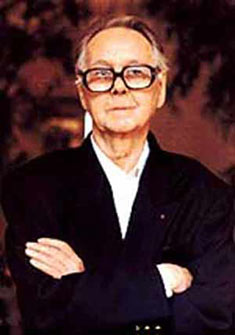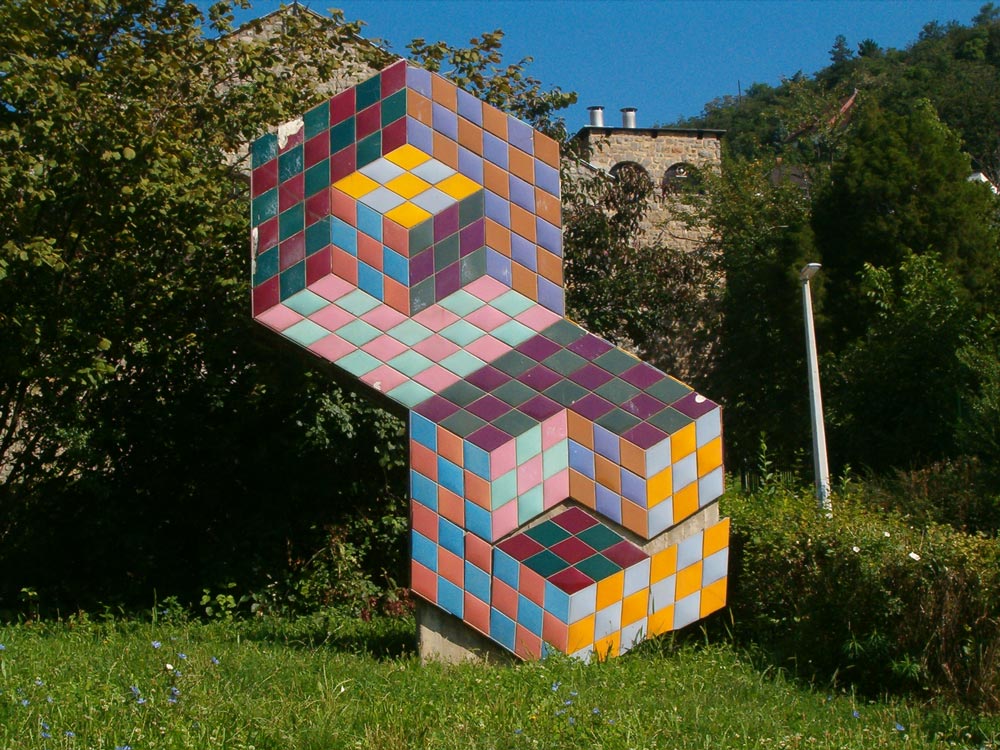| Victor Vasarely | |
|---|---|
 |
|
| Born | Vásárhelyi Győző Apr. 9, 1906 Pécs, Hungary |
| Died | Mar. 15, 1997 (at age 90) Paris, France |
| Nationality | Hungarian-French |
| Movement | Op-art |
| Field | Painting |
| Works | View Complete Works |
Victor Vasarely (1906-1997) was an Op-art artist who was born in Hungary and spent much of his career painting in France. He helped to define the genre of Op-art, and some of his works are considered early examples of the style.
Early Life
Vasarely was born in Hungary and studied medicine at Budapest University in 1925. He eventually gave up on medicine and decided to pursue painting. He studied originally at Sandor Bortnyik’s workshop, which was then considered a prominent place to study academic painting. The workshop where he studied offered study specifically in typographical design and graphic art.
Painting Career
Vasarely painted Blue Study and Green Study in 1929. He married another painter, Claire Spinner, in 1930. They had two sons together. Vasarely worked in advertising in the late 1920s, designing posters for a ball-bearings company. In the 1930s, he developed into a poster artist and graphic designer with his own style that involved combining patterns and natural images.
Move to Paris
In 1930, Vasarely moved to Paris and continued working as a graphic artist. Here he was employed at Havas, Draeger and Devambez, an advertising agency, until 1935. He didn’t have a lot of interaction with other artists but desired to open a workshop resembling the type he had learned painting from. After World War II had ended, he did just that. The atelier was located near the center of Paris.
Vasarely’s Art
Vasarely’s art was based on optical illusion. He had a geometric abstract style that used a variety of materials. His selection of colors and forms, however, was somewhat limited. From the late 1920s until the mid-1940s, he did much experimentation with perspective and shadowing. His work Zebras is still considered one of the earliest examples of Op-art. Also notable in this time period are his Chess Board and Girl-power.
From 1944 to 1947, Vasarely did a great deal of experimentation with his artwork. He attempted to incorporate cubist, expressionist, and surrealist styles into his paintings. He was even referred to as a surrealist by an artist of the time. Vasarely later would say that he was “on the wrong track” during this period. It seemed that Vasarely was still discovering his own style at this time.
In the late 1940s and early 1950s, Vasarely began to develop his own unique style. He named works according to their inspiration. For example, he used the name Denfert to refer to paintings that were influenced by the Paris Denfert (metro station) walls. His Elles-Isles works are centered around an ellipsoid design inspired by the pebbles on the sand during his trip to the Breton coast. His Gordes/Cristal works were inspired by cube-shaped houses in Gordes, where he spent his time in the summer.
In the early 1950s, Vasarely experimented with kinetic images. He would superimpose acrylic glass, which gave the impression that the painting moved depending on the perspective. Then he incorporated black and white photography into those paintings. For example, Tribute to Malevitch is a large ceramic wall that is found in the University of Caracas and is considered one of his major works. He also during this time published a book called the Yellow Manifest, in which he discusses the role visual kinetics has on the viewer of the art.
In the late 1950s and early 1960s, Vasarely developed his new method of Unites Plastiques. In this style, geometric forms are cut out of colored material and arranged in patterns. This led to serial art, which involved a long repetition of forms and colors.
From 1965 on, he worked on “The Tribute to the Hexagon” series, which involved permutations of color and variations which formed a moving illusion. In 1965, a Museum of Modern Art exhibition called “The Responsive Eye” was created which included Vasarely.
Later Life
Vasarely opened his own museum in 1970 that included over 500 of his works. Others would follow as an attempt to pay homage to this innovator. In 1982, 154 of Vasarely’s serigraphs were carried by Jean-Loup Chretien as he went on board the spacecraft Salyut 7. Two museums to Vasarely have also been opened in Hungary, the second of which was opened in 1987. Vasarely is considered one of the originators of Op-art and a unique and visually appealing artist. His introduction of geometric images was a unique and intriguing addition to the art world. He passed away in Paris in 1997 at the age of 90.
